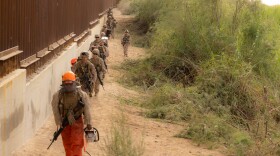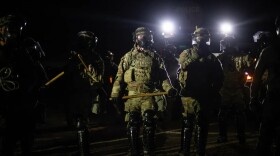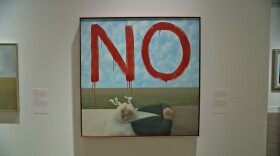The outline of a new San Diego City Council district is taking shape. We'll hear what the new boundary lines for voting districts will be in the City of San Diego.
Guests
Midori Wong is the Chief of Staff of the City of San Diego's Redistricting Commission
Brian Pollard, community activist from Valencia Park. He is a member of the NAACP, the Coalition of Neighborhood Councils, and works with the Latino Redistricting Committee.
Read Transcript
This is a rush transcript created by a contractor for KPBS to improve accessibility for the deaf and hard-of-hearing. Please refer to the media file as the formal record of this interview. Opinions expressed by guests during interviews reflect the guest’s individual views and do not necessarily represent those of KPBS staff, members or its sponsors.
CAVANAUGH: I'm Maureen Cavanaugh, it's Thursday, July 1st. Coming up this hour, we'll get a live report,.
And we'll hear about what San Diego actually gets out of all the ComiCon hoopla. First we all get a look at what the new boundary lines for voting districting will be for the City of San Diego. The city's redistricting commission votes on a primary map today, which includes the brand-new ninth district. Joining us to talk about this new map, are my guests, Midori Wong, the Chief of Staff of the City of San Diego's Redistricting Commission. Hello.
WONG: Thanks for having me.
CAVANAUGH: And Brian Pollard is community activist from Valencia park. He is a member of the NAACP, the Coalition of Neighborhood Councils, and works with the Latino Redistricting Committee.
POLLARD: Hi, Maureen. Thanks again for having me here.
CAVANAUGH: Midori, let's start off with a little basic idea of why this is happening. Why do the city's voting districts need to be changed?
WONG: Sure, Maureen, redistricting actually occurs every ten years at many levels of government. And these boundaries are redrawn coinciding with the release of U.S. census data, because we can see how neighborhoods have grown and changed over the past decade. The city's commission's charge has been to create these nine council districts as directed by the voters who approved a city charter amendment last June, which means we're not only adjusting the boundaries for the current eight districts but adding a new ninth district. This is really important because you want to make sure that the balance of population is as equal as possible in each district so that each person has equal access to role representation. This is a concept we call one person, 1 vote.
CAVANAUGH: And because voters approved the so called strong mayor form of government, we need an additional district so that we have people voting on the City Council won't be split evenly between 4 and 4, they have now a 5/4 majority. What are your goals in terms of balancing out representation in the districts?
WONG: The coalition needs to consider -- as well as such documents as the constitution, the federal voting rights act in 1965, and related cases and statutes. But some of the traditional principles that the commission uses as a guide are not only to equalize that population, but also to do things like respect communities of interest, to use contiguous territory with reasonable access, serve natural boundaries, dividing lines, try to draw geographically compact districts, and the commission also doesn't consider incumbents in the process.
CAVANAUGH: Listeners can see the new map and the old map on the KPBS.org right now. If we're looking at the draft redistricting map, can you tell us what some of the highlights are?
WONG: Sure. And the key thing to remember here is everything looks a little bit different. The addition of a ninth district means that everything really changes. But some of the highlights are that downtown has been united with up down. This is a reflection of testimony that the commission heard from peninsula and beach community residents who felt they didn't have much in common downtown as was complimented by some testimony from members of the community who wanted to unite the neighborhoods surrounding Balboa Park. And you also see that the ninth district primarily unites the neighborhoods of City Heights, which currently are split into three districts, as well as a portion of southeast San Diego, and the college neighborhoods.
CAVANAUGH: So downtown would now be in district three.
WONG: That's correct.
CAVANAUGH: And District five loses Mira Mesa.
WONG: Yes, that's correct. District six actually combines Mira Mesa, a portion of Rancho Peñasquitos, Kearny Mesa, Mira Mar, and sareasono valley.
CAVANAUGH: As you say, the lines have really changed in a lot of areas here to make way for this new ninth district. Brian Pollard, you spoke with us just last month with criticisms about the lack of minority representation in the new San Diego County redistricting map. What do you think about the city's preliminary map?
POLLARD: Well, I mixed feelings about the map. They have deputy the -- the redistricting commission has done a great job of listening to folks from all over the city. And I could speak for district four, that we are pleased as punch. There are going to be some concerns. We have lost mount hope and a portion of mountain view as well as ridge view. But we've gained Rolando village and red wood. And I think that those additional communities will do a lot for district four. I be know -- I know that one of their major issues are parks. And the last I was told that district four has been very, very low in the number of parks. So hopefully with them joining district four, they will get higher on the priority list for some of the park projects that they have currently going. With district nine, that's the other side. It is that it is great that there's now a district encompasses most of the immigrants and multilingual residents. There would -- it would have been nice if the LRC, the Latino redistricting commission map was considered more favorably. But the commission saw differently. So now the issue is for the immigrants and the multiling William folks to gather the residents, get them registered to vote, and to get them out to vote.
CAVANAUGH: Brian, which groups in your opinion are not being adequately represented by the City Council now?
POLLARD: Well, I guess there's two groups that pop right into my mind. Based upon the population, it would seem that the Latino residents, the multicultural immigrant, multilingual folks need representation. The census dictates that. They are close to 30% of the population. I guess on a pure level, they should have three. However, two is better than one. The other group I think is under represented still are the Asian communities. They made a very, very good attempt as they did the last redistricting process with a lot of testimony, a lot of community of interest issues, but they fell short this time around as well. So I think those two groups are probably the ones that still need to be represented in the City Council.
CAVANAUGH: Midori, what are the legal requirements for redistricting? What are the goals of the process?
WONG: A couple of the traditional principles that I outlined earlier are kind of the corner stone principles involved. So again, equalizing of population, complying with the voting rights act, respecting communities of interest. The city charter also includes a provision for achieving a redistricting plan that creates fair and equal representation for language minorities in the city. So there are a number of guidelines that the commission has to use, and the commission really has to consider the totality of all of the different circumstances in evidence in order to create a plan.
CAVANAUGH: There's actually some things you can't do when you're considering the legality of redistricting, right?
WONG: Do you mean in drawing districts?
CAVANAUGH: Yes.
WONG: Sure. Absolutely. There are things having to do with the voting rights act, where you need to not dilute minority vote for protected classes that are outlined in the VRA. You also need to make sure that the district is continuous, meaning you can't have certain parts that are geographically split off from the other parts. And you also want to try to, again, draw as geographically compact a district as is practical to do so.
CAVANAUGH: In common parlance, in talking about this, in city fortunatelies, and I know a lot of reporters refer to the Asian district as you were talking about, before, Brian. And the Latino district. But that's not really the we this redistricting process actually happens, is it, Brian?
POLLARD: No. It isn't. And race should not be the primary driver behind drawing the lines. But it is an important one. And often, it gets -- and I've noticed it in the -- some of the conversations and the testimony, race becomes in my opinion a divisive sort of area for and against. And there's a balancing act that I understand from the commission's standpoint that they need to weigh. It is not a primary -- not the primary factor, but it is certainly a very important factor in this process.
CAVANAUGH: What, for instance what, Brian, would make a community of interest out of the residents of this new proposed district nine?
POLLARD: I can tell you what we've used in district four, and what we looked at after going to a lot of different groups and residents throughout the district. They were the ones that were telling me what the communities of interest were. It included churches, it included shopping centers, easy access from one neighborhood to another, transportation corridors, median income. Issues like -- social issues such as believe it or not gang activity, crime, security. So there's a multitude, and it's not clearly defined, but it's the sort upon of thing that you know it when you see it. And and it is something that is critical to the decision making process, because that community of interest piece joins the neighborhoods closer together.
CAVANAUGH: I'm sorry, go ahead.
POLLARD: No, I'm finished.
CAVANAUGH: Okay. Midori, I was going to ask you where you are in this process. Now you've come out with these maps. What happens at the meeting later today in.
WONG: At the meeting tonight, the commission is going to be considering adoption of this plan. And I should mention that along with a map, it also includes a filing brief, and that's a legal document that explains the reasons and analysis why the commission made the decision its did for this preliminary (. After that, the commission will go back out into the community and listen to public testimony. We'll be taking this plan out on the road for a series of five public hearings over the next two weeks. And these are opportunities to provide an over view of the plan and to allow the public to give additional feedback to the commission directly.
CAVANAUGH: How preliminary, really, is this preliminary map? A lot of meetings and a lot of time has gone into this. What would it take for you to now change what you've got it?
WONG: It's really anyone's guess. We had strived to have as robust a public participation process in the very beginning. We have had 33 approximate public hearings over the past several months, with participation numbering into the thousands when you combine speakers, letters, mails, telephone calls. So this is really our best effort to this point. We're committed to going back out into the community, and hearing concerns, and what improvements could be made. And the commission will use this testimony in their final deliberations before adopting a final plan.
CAVANAUGH: And after that?
WONG: And after that, the plan becomes effective 30 days from adoption. It is subject to right of referendum.
POLLARD: I just wanted to basically off the thank the commission. And Midori, you as well, you folks have done an excellent job at -- in the outreach in listening to all the testimony. And the maps, the 19, I guess it's 19 B, I believe, that's going to be considered this evening, has a support district four. We have already met with redwood and Rollando village, and I think we're working on getting closer together. The community of unity coalition, we did have a map for the LRC. And it wasn't accepted in its entirety. But I just want to thank you very, very much, and all of the commissioners, and Midori yourself as well.
WONG: Thank you so much. I think Brian is right when he says it's a balancing act. And I think folks will see that the proposed plan is a reflection bothef testimony as well as trying to respect those traditional redistricting principles. But we're really grateful for the tremendous amount of engagement that we've seen from the very beginning, from residents all over the city. They make our job easier by getting involved and staying involved.
CAVANAUGH: I want to tell our listeners once again, if they want to check out this map, it's on our website at KPBS.org. And you can also see the list of dates for those public hearings on our website, KPBS.org. I've been speaking with Midori Wong of San Diego's redistricting commission, and community activist Brian Pollard. I want to thank you both.
POLLARD: Thank you so much again.
WONG: Thank you so much, Maureen.







